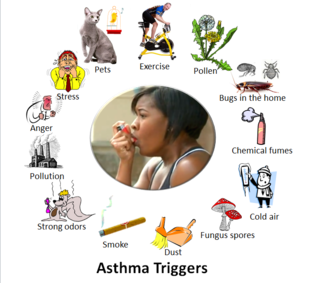
Bronchoconstriction is the constriction of the airways in the lungs due to the tightening of surrounding smooth muscle, with consequent coughing, wheezing, and shortness of breath.

Bronchoconstriction is the constriction of the airways in the lungs due to the tightening of surrounding smooth muscle, with consequent coughing, wheezing, and shortness of breath.
The condition has a number of causes, the most common being emphysema as well as asthma. Exercise and allergies can bring on the symptoms in an otherwise asymptomatic individual. [1]
With emphysema the shortness of breath due to effective bronchoconstriction from excessive very thick mucus blockage (it is so thick that great difficulty is encountered in expelling it resulting in near exhaustion at times) can bring on panic attacks unless the individual expects this and has effectively learned pursed lip breathing to more quickly transfer oxygen to the blood via the damaged alveoli resulting from the disease. The most common cause of emphysema is smoking and smoking cessation is mandatory if this incurable disease is to be treated. Prevention of bronchoconstriction by this pathway is vital for people with emphysema and there are several anticholinergic medications that in combination with mucous thinning agents such as Guaifenesin cause significant improvement in breathing.
More generally termed exercise-induced asthma , the preferred and more accurate term exercise-induced bronchoconstriction better reflects underlying pathophysiology. It is also preferred due to the former term giving the false impression that asthma is caused by exercise.
In a patient with EIB, exercise initially follows the normal patterns of bronchodilation. However, by three minutes, the constriction sets in, which peaks at around 10–15 minutes, and usually resolves itself by an hour. During an episode of this type of bronchoconstriction, the levels of inflammatory mediators, particularly leukotrienes, histamine, and interleukin, increase. TH2-type lymphocytes are activated, with an increase in T cells expressing CD25 (IL-2R), and B cells expressing CD 23, causing increased production of IgE. After exercise, the conditions will fade within one to three minutes. In most people with EIB, this is followed by a refractory period, of generally less than four hours, during which if exercise is repeated, the bronchoconstriction is less emphasised. This is probably caused by the release of prostaglandins.
The underlying cause of this type of bronchoconstriction appear to be the large volume of cool, dry air inhaled during strenuous exercise. The condition appears to improve when the air inhaled is more fully humidified and closer to body temperature.
This specific condition, in the general population, can vary between 7 and 20 percent. This increases to around 80 percent in those with symptomatic asthma. In many cases, however, the constriction, even during or after strenuous exercise, is not clinically significant except in cases of severe to moderate emphysema.
In May 2013, the American Thoracic Society issued the first treatment guidelines for EIB. [2]
While a different cause, this has very similar symptoms, namely the immunological reaction involving release of inflammatory mediators.
Inhalation of allergens in sensitized subjects develops into bronchoconstriction within 10 minutes, reaches a maximum within 30 minutes, and usually resolves itself within one to three hours. In some subjects, the constriction does not return to normal, and recurs after three to four hours, which may last up to a day or more. The first is named the early asthmatic response, and the latter the late asthmatic response.
Bronchoconstriction can occur as a result of anaphylaxis, even when the allergen is not inhaled.
Bronchoconstriction is defined as the narrowing of the airways in the lungs (bronchi and bronchioles). Air flow in air passages can get restricted in three ways: [3]
The bronchial spasm is due to the activation of parasympathetic nervous system. Postganglionic parasympathetic fibers will release acetylcholine causing the constriction of the smooth muscle layer surrounding the bronchi. These smooth muscle cells have muscarinic M3 receptors on their membrane. The activation of these receptors by acetylcholine will activate an intracellular G protein, that in turn will activate the phospholipase C pathway, that will end in an increase of intracellular calcium concentrations and therefore contraction of the smooth muscle cell. The muscle contraction will cause the diameter of the bronchus to decrease, therefore increasing its resistance to airflow. [4]
Bronchoconstriction is common in people with respiratory problems, such as asthma, COPD, and cystic fibrosis.
Medical management of transient bronchoconstriction or chronic bronchitis depends on the severity and etiology of the underlying disease and can be treated with combinations of the following medications:
A bronchodilator or broncholytic is a substance that dilates the bronchi and bronchioles, decreasing resistance in the respiratory airway and increasing airflow to the lungs. Bronchodilators may be originating naturally within the body, or they may be medications administered for the treatment of breathing difficulties, usually in the form of inhalers. They are most useful in obstructive lung diseases, of which asthma and chronic obstructive pulmonary disease are the most common conditions. Although this remains somewhat controversial, they might be useful in bronchiolitis and bronchiectasis. They are often prescribed but of unproven significance in restrictive lung diseases.

The respiratory tract is the subdivision of the respiratory system involved with the process of conducting air to the alveoli for the purposes of gas exchange in mammals. The respiratory tract is lined with respiratory epithelium as respiratory mucosa.

The bronchioles or bronchioli are the smaller branches of the bronchial airways in the lower respiratory tract. They include the terminal bronchioles, and finally the respiratory bronchioles that mark the start of the respiratory zone delivering air to the gas exchanging units of the alveoli. The bronchioles no longer contain the cartilage that is found in the bronchi, or glands in their submucosa.

Bronchospasm or a bronchial spasm is a sudden constriction of the muscles in the walls of the bronchioles. It is caused by the release (degranulation) of substances from mast cells or basophils under the influence of anaphylatoxins. It causes difficulty in breathing which ranges from mild to severe.

Ipratropium bromide, sold under the trade name Atrovent among others, is a type of anticholinergic medication which is applied by different routes: inhaler, nebulizer, or nasal spray, for different reasons.

Fluticasone/salmeterol, sold under the brand name Advair among others, is a fixed-dose combination medication containing fluticasone propionate and salmeterol. It is used in the management of asthma and chronic obstructive pulmonary disease (COPD). It is used by inhaling the medication into the lungs.

Salmeterol is a long-acting β2 adrenergic receptor agonist (LABA) used in the maintenance and prevention of asthma symptoms and maintenance of chronic obstructive pulmonary disease (COPD) symptoms. Symptoms of bronchospasm include shortness of breath, wheezing, coughing and chest tightness. It is also used to prevent breathing difficulties during exercise.

Budesonide/formoterol, sold under the brand name Symbicort among others, is a fixed-dose combination medication used in the management of asthma or chronic obstructive pulmonary disease (COPD). It contains budesonide, a steroid and formoterol, a long-acting β2-agonist (LABA). The product monograph does not support its use for sudden worsening or treatment of active bronchospasm. However, a 2020 review of the literature does support such use. It is used by breathing in the medication.

Beta2-adrenergic agonists, also known as adrenergic β2 receptor agonists, are a class of drugs that act on the β2 adrenergic receptor. Like other β adrenergic agonists, they cause smooth muscle relaxation. β2 adrenergic agonists' effects on smooth muscle cause dilation of bronchial passages, vasodilation in muscle and liver, relaxation of uterine muscle, and release of insulin. They are primarily used to treat asthma and other pulmonary disorders. Bronchodilators are considered an important treatment regime for chronic obstructive pulmonary disease (COPD) and are usually used in combination with short acting medications and long acting medications in a combined inhaler.

Long-acting β adrenoceptor agonists (LABAs) are beta-adrenergic agonists usually prescribed for moderate-to-severe persistent asthma and chronic obstructive pulmonary disease (COPD).

Levosalbutamol, also known as levalbuterol, is a short-acting β2 adrenergic receptor agonist used in the treatment of asthma and chronic obstructive pulmonary disease (COPD). Evidence is inconclusive regarding the efficacy of levosalbutamol versus salbutamol or salbutamol-levosalbutamol combinations, though levosalbutamol is believed to have a better safety profile due to its more selective binding to β2 receptors versus β1.
A bronchial challenge test is a medical test used to assist in the diagnosis of asthma. The patient breathes in nebulized methacholine or histamine. Thus the test may also be called a methacholine challenge test or histamine challenge test respectively. Both drugs provoke bronchoconstriction, or narrowing of the airways. Whereas histamine causes nasal and bronchial mucus secretion and bronchoconstriction via the H1 receptor, methacholine utilizes the M3 receptor for bronchoconstriction. The degree of narrowing can then be quantified by spirometry. People with pre-existing airway hyperreactivity, such as asthmatics, will react to lower doses of drug.

Obstructive lung disease is a category of respiratory disease characterized by airway obstruction. Many obstructive diseases of the lung result from narrowing (obstruction) of the smaller bronchi and larger bronchioles, often because of excessive contraction of the smooth muscle itself. It is generally characterized by inflamed and easily collapsible airways, obstruction to airflow, problems exhaling, and frequent medical clinic visits and hospitalizations. Types of obstructive lung disease include asthma, bronchiectasis, bronchitis and chronic obstructive pulmonary disease (COPD). Although COPD shares similar characteristics with all other obstructive lung diseases, such as the signs of coughing and wheezing, they are distinct conditions in terms of disease onset, frequency of symptoms, and reversibility of airway obstruction. Cystic fibrosis is also sometimes included in obstructive pulmonary disease.

Tiotropium bromide, sold under the brand name Spiriva among others, is a long-acting bronchodilator used in the management of chronic obstructive pulmonary disease (COPD) and asthma. Specifically it is used during periods of breathing difficulty to prevent them from getting worse, rather than to prevent them from happening. It is used by inhalation through the mouth. Onset typically begins within half an hour and lasts for 24 hours.

Chronic obstructive pulmonary disease (COPD) is a type of progressive lung disease characterized by long-term respiratory symptoms and airflow limitation. GOLD 2024 defined COPD as a heterogeneous lung condition characterized by chronic respiratory symptoms due to abnormalities of the airways and/or alveoli (emphysema) that cause persistent, often progressive, airflow obstruction.
β2-adrenoceptor agonists are a group of drugs that act selectively on β2-receptors in the lungs causing bronchodilation. β2-agonists are used to treat asthma and COPD, diseases that cause obstruction in the airways. Prior to their discovery, the non-selective beta-agonist isoprenaline was used. The aim of the drug development through the years has been to minimise side effects, achieve selectivity and longer duration of action. The mechanism of action is well understood and has facilitated the development. The structure of the binding site and the nature of the binding is also well known, as is the structure activity relationship.

Beclometasone/formoterol/glycopyrronium, sold under the brand name Trimbow among others, is an inhalable fixed-dose combination medication for the treatment of chronic obstructive pulmonary disease (COPD) and asthma. It contains beclometasone dipropionate, formoterol fumarate dihydrate, and glycopyrronium bromide.
Fluticasone furoate/umeclidinium bromide/vilanterol, sold under the brand name Trelegy Ellipta among others, is a fixed-dose combination inhaled medication that is used for the maintenance treatment of chronic obstructive pulmonary disease (COPD). The medications work in different ways: fluticasone furoate is an inhaled corticosteroid (ICS), umeclidinium is a long-acting muscarinic antagonist (LAMA), and vilanterol is a long-acting beta-agonist (LABA).

Asthma triggers are factors or stimuli that provoke the exacerbation of asthma symptoms or increase the degree of airflow disruption, which can lead to an asthma attack. An asthma attack is characterized by an obstruction of the airway, hypersecretion of mucus and bronchoconstriction due to the contraction of smooth muscles around the respiratory tract. Its symptoms include a wide range of manifestations such as breathlessness, coughing, a tight chest and wheezing.
Asthma-Chronic Obstructive Pulmonary Disease (COPD) Overlap (ACO), also known as Asthma-COPD Overlap Syndrome (ACOS) is a chronic inflammatory, obstructive airway disease in which features of both asthma and COPD predominate. Asthma and COPD were once thought of as distinct entities, however in some, there are clinical features of both asthma and COPD with significant overlap in pathophysiology and symptom profile. It is unclear whether ACO is a separate disease entity or a clinical subtype of asthma and COPD. The pathogenesis of ACO is poorly understood, but it is thought to involve both type 2 inflammation as well as type 1 inflammation. The incidence and prevalence of ACO are not well known. The risk factors for ACO are also incompletely understood, but tobacco smoke is known to be a major risk factor.